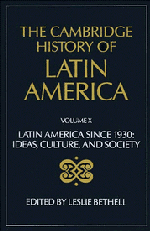Book contents
- Frontmatter
- 1 The multiverse of Latin American identity, c. 1920–c. 1970
- 2 Latin American narrative since c. 1920
- 3 Latin American poetry, c. 1920–1950
- 4 Latin American poetry since 1950
- 5 Indigenous literatures and cultures in twentieth-century Latin America
- 6 Latin American music, c. 1920—c. 1980
- 7 Latin American architecture, c. 1920–c. 1980
- 8 Latin American art since c. 1920
- 9 Latin American cinema
- 10 Latin American broadcasting
- Bibliographical essays
- References
5 - Indigenous literatures and cultures in twentieth-century Latin America
Published online by Cambridge University Press: 28 March 2008
- Frontmatter
- 1 The multiverse of Latin American identity, c. 1920–c. 1970
- 2 Latin American narrative since c. 1920
- 3 Latin American poetry, c. 1920–1950
- 4 Latin American poetry since 1950
- 5 Indigenous literatures and cultures in twentieth-century Latin America
- 6 Latin American music, c. 1920—c. 1980
- 7 Latin American architecture, c. 1920–c. 1980
- 8 Latin American art since c. 1920
- 9 Latin American cinema
- 10 Latin American broadcasting
- Bibliographical essays
- References
Summary
sources and interpretation
During the last half-century accounts of indigenous America have pointed to a deeper and wider coherence, and a greater resilience, than was for merly recognized in academic and official discourse, notably in mainstream Anglo-American social anthropology. As early as the 1950s, Claude Lévi-Strauss celebrated not just the coherence of American culture but its prime role in the ‘cumulative history’ of the planet, pointing to its distinctive achievement in such endeavours as plant genetics, medicine (anaesthetics, poisons) and mathematics. Since then scholarship has abundantly vindicated this view while drawing in further areas of common reference, like cosmogony and visual language.
In the matter of script, analysis has revealed characteristics common to the recording systems used in the two principal urban societies of the continent, Tahuantinsuyu or the Inca empire of the Andes, and Mesoamerica. Both the quipu of Tahuantinsuyu, whose logic and codes have been adequately described only in the last few decades, and the books of Mesoamerica are notable for their numeracy and their reliance on such principles as place-value notation. Mesoamerican script conventions have generally become more comprehensible thanks in part to high-quality reproductions of inscribed texts and superb facsimiles of the screenfold books and codices. The hieroglyphic script peculiar to the lowland Maya is now being successfully read according to phonetic principles (advocated by the Soviet scholar Yuri Knorosoz), which effectively link living Maya speech with signs shaped 1700 years ago.
- Type
- Chapter
- Information
- The Cambridge History of Latin America , pp. 287 - 306Publisher: Cambridge University PressPrint publication year: 1995

